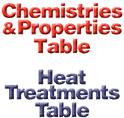
(AISI A9)
| Typical Chemistry | |
| Carbon | 0.50% |
| Manganese | 0.30% |
| Silicon | 1.00% |
| Chromium | 5.20% |
| Vanadium | 1.00% |
| Molybdenum | 1.40% |
| Nickel | 1.40% |
| Typical Applications | ||
| Coining Dies | Extrusion Dies | |
| Piercing Tools | Punches | |
| Heading Dies | Upset Dies | |
| Forging Dies | Shear Blades | |
| Insert Holders | Trim Dies | |
- Hardening
Critical Temperature: 1480F(805C).
Preheat: 1400/1450F(760/790C)
High Heat: 1800/1850F(980/1010C), hold 20/45 minutes at temperature.
Quench: Air or vacuum quench to hand warm, 150F(65C). Salt bath or interrupted oil may be required to attain maximum hardness in large sections. Interrupted oil quenching consists of quenching in oil until just black (1100F(540/595C)), then air cooling to hand warm, 150F(65C).
Temper: 1000/1100F(540/595C) is normally recommended. Hold one hour per inch of thickness, two hours minimum, four hours recommended. Temper twice.
Cryogenic treatments: Refrigeration treatments are generally of limited utility for materials with multiple tempers over 1000F(540C).
|
|
||||
|
|
Toughness, Charpy C-notch |
||
|
|
|
ft-lbs |
|
|
|
||||
| 900 | 480 | 56 | 50 | 68 |
| 950 | 510 | 56.5 | 50 | 68 |
| 1000 | 540 | 54.5 | 112 | 152 |
| 1050 | 565 | 52.5 | 134 | 182 |
| 1100 | 595 | 47 | 151 | 205 |
|
|
||||

|
|
||||
|
|
Toughness, Charpy C-notch |
||
|
|
|
ft-lbs |
|
|
|
||||
| 900 | 480 | 57 | 50 | 68 |
| 950 | 510 | 58 | 55 | 75 |
| 1000 | 540 | 56 | 128 | 174 |
| 1050 | 565 | 54 | 139 | 188 |
| 1100 | 595 | 49 | 140 | 190 |
|
|
||||
Crucible A9 can be given standard surface treatments such as nitriding, titanium nitride coating, and hard chrome plating if desired.
Annealing
A. Heat to 1600F(870C), hold two hours, cool slowly, 25F(15C) per hour maximum, to below 1000F(540C), then air cool.
OR
B. Heat to 1600F(870C), hold 2 hours, cool to 1300/1400F(705/760C), hold 6 hours, then air cool.
Typical annealed hardness: 217/241 BHN
Stress Relieving
Annealed Material: 1100/1300F(595/740C), hold 2 hours, cool in still air.
Hardened Material: 50F(30C) below last tempering temperature, hold two hour, cool in still air.
Welding
Use hot-work (H13 or H12 or A8 type) tool steel filler material.
Annealed material: Preheat to 800/1000F(425/540C); maintain above 600F(315C) during welding. Allow to cool to hand warm (150F(65C)) after welding. Reanneal, or temper 1300/1400F(705/760C) for 6 hours.
Hardened material: Preheat to 100F(55C) below tempering temperature (800F(425C) minimum). Maintain over 600F(315C) during welding. Allow to cool to hand warm (150F(65C)) after welding. Retemper twice at 25/50F(15/30C) below original tempering temperature.
Physical Properties
Modulus of Elasticity ...................................................................30 psi x 106 (207 GPa)
Density .......................................................................................0.281 lb/in3 (7780 kg/m3)
Specific gravity ............................................................................................................7.78
Thermal Conductivity ................................... 15 BTU/hr/ft/°F(200F) 25.8 W/m°K(95C)
Thermal Expansion
|
|
||
|
|
|
|
|
|
|
|
|
|
|
|
|
|
|
|
|
|
|
|